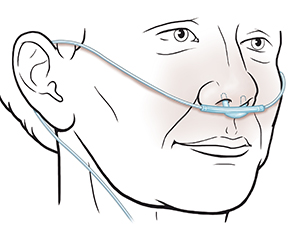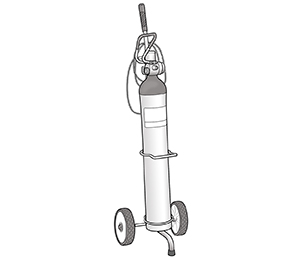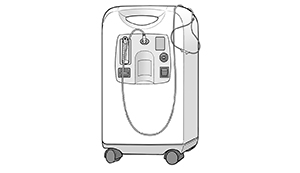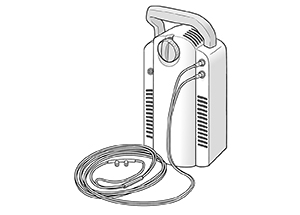If Oxygen Is Prescribed
Supplemental oxygen is prescribed if tests show that the oxygen level in your blood is too low. If the level stays too low for too long, serious problems can occur in many parts of the body. Supplemental oxygen helps to ease your symptoms and prevent future problems by getting more oxygen to the blood. Depending on your test results, you may need oxygen all the time. Or it may only be needed during certain activities, such as exercise or sleep. When oxygen is prescribed, you’ll be referred to a medical equipment company. They will set up the oxygen unit and teach you how to use it.
Nasal cannula
 |
| The nasal cannula should be placed under the nose with the prongs curved toward the face. |
Oxygen is most often inhaled through a nasal cannula. This is a lightweight tube. It has 2 hollow prongs that fit just inside the nose.
Types of supplemental oxygen
Prescribed oxygen comes in several forms. You may use more than 1 type, depending on when you need oxygen:
-
Compressed oxygen. This is oxygen gas stored in a tank. The oxygen is stored under pressure. So these tanks must be handled carefully. Gauges on the tank can be used to adjust the oxygen flow rate. Your healthcare provider will figure out what this flow rate should be. Small tanks can be carried. Larger tanks are on wheels. They can be pulled around the house.

-
An oxygen concentrator. This is a machine about the size of a large suitcase. It plugs into an electrical outlet. (A back-up oxygen supply is advised in case of a power outage.) The machine takes oxygen from the air and concentrates it. It’s then delivered to you through plastic tubing. The tubing is long enough so that you can move around the house. When you’re using the concentrator, it must be kept somewhere that has a good supply of fresh air. Don’t keep it in a confined space, like a closet. You may be set up on a concentrator if you need oxygen all the time or while you’re sleeping. You can also get a smaller, lightweight, portable oxygen concentrator to take with you. Many people prefer these to help them continue an active lifestyle.

-
Liquid oxygen. This results when oxygen gas is cooled to a very low temperature. It’s kept in special containers that stay at this low temperature. When you use liquid oxygen, it’s warmed and becomes gas before reaching the cannula. Most tanks come with a portable unit that you can carry or pull on a cart. Some of these weigh only a few pounds. Liquid oxygen units are easy to carry around. If you need oxygen all the time or during activity, this kind of unit can help you stay active.

Oxygen is prescribed just for you
Your healthcare provider will prescribe oxygen based on your needs. Here are a few things you should know:
-
A therapist from the medical equipment company will explain when to use oxygen and what type to use. You’ll be taught how to use and maintain your oxygen equipment.
-
You must use the exact rate of oxygen prescribed for each activity. Don’t increase or decrease the amount on your own. Ask your healthcare provider first.
-
Supplemental oxygen is a medicine. It’s not addictive. It causes no side effects when used as directed.
Online Medical Reviewer:
Allen J Blaivas DO
Online Medical Reviewer:
Daphne Pierce-Smith RN MSN
Online Medical Reviewer:
Ronald Karlin MD
Date Last Reviewed:
11/1/2021
© 2000-2024 The StayWell Company, LLC. All rights reserved. This information is not intended as a substitute for professional medical care. Always follow your healthcare professional's instructions.